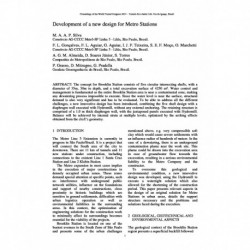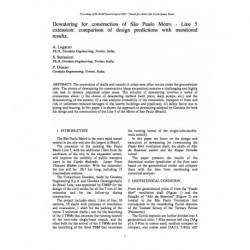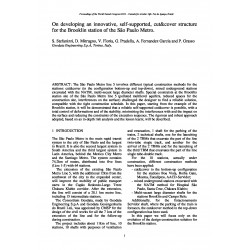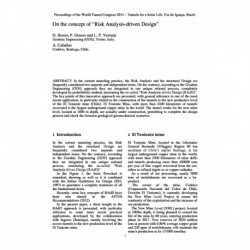No document
Search & filter
Search for a publication
Search & filter
List of products by author: P. Grasso
-
Development of a new design for Metro Stations
Abstract: The concept for Brooklin Station consists of five circular intersecting shafts, with a diameter of 35m, 30m in depth, and a total excavation surface of 4250 m². Water control and management is fundamental as the entire Brooklin Station area is near a contaminated zone, making any dewatering process impossible to execute. Since the water level is near the surface, structural demand is also very...
0,00 € -
Dewatering for construction of São Paulo Metro - Line 5 extension: comparison of design predictions with monitored...
Abstract: The excavation of shafts and tunnels in urban area often occurs under the groundwater table. The choice of dewatering for construction (deep excavation) remains a challenging and highly risk task in densely populated urban areas. The solution of dewatering involves a series of evaluations about: i) the choice of dewatering method (well point, deep pumps, etc.) and the dimensioning of the...
0,00 € -
On developing an innovative, self-supported, cut and cover structure for the Brooklin station of the São Paulo Metro
Abstract: The São Paulo Metro line 5 involves different typical construction methods for the stations: cut&cover (in the configuration bottom-up and top-down), mined underground stations excavated with the NATM, multi-secant large diameter shafts. Special constraints at the Brooklin station site of the São Paulo Metro line 5 (polluted multilevel aquifers, reduced spaces for the construction site,...
0,00 € -
On the concept of “Risk Analysis-driven Design”
Abstract: In the current tunneling practice, the Risk Analysis and the structural Design are frequently considered two separate and independent items. On the contrary, according to the Geodata Engineering (GDE) approach they are integrated in one unique rational process, completely developed by probabilistic method, structuring the so-called “Risk Analysis-driven Design (RAdD)”. The key points of this...
0,00 €




